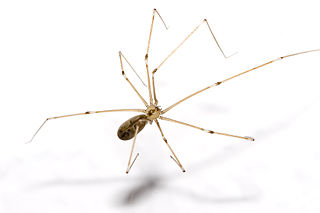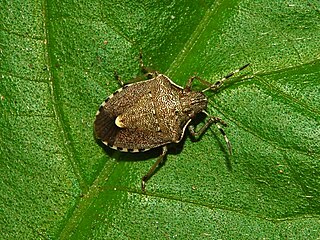
The Mygalomorphae, or mygalomorphs, are an infraorder of spiders. The name is derived from the Greek mygalē, meaning "shrew", plus morphē meaning form or shape. An older name for the group is Orthognatha, derived from the orientation of the fangs which point straight down and do not cross each other. In 1802, Charles Athanase Walckenaer separated mygalomorph spiders into a separate genus, Mygale, leaving all other spiders in Aranea.

Huntsman spiders, members of the family Sparassidae, are known by this name because of their speed and mode of hunting. They are also called giant crab spiders because of their size and appearance. Larger species sometimes are referred to as wood spiders, because of their preference for woody places. In southern Africa the genus Palystes are known as rain spiders or lizard-eating spiders. Commonly they are confused with baboon spiders from the Mygalomorphae infraorder, which are not closely related.

The Pholcidae are a family of araneomorph spiders. The family contains over 1,800 pholcids, including those commonly known as the marbled cellar spider , daddy long-legs spider, granddaddy long-legs spider, carpenter spider, daddy long-legger, vibrating spider, gyrating spider, long daddy, and skull spider. The family, first described by Carl Ludwig Koch in 1850, is divided into 94 genera.

The Goliath birdeater belongs to the tarantula family Theraphosidae. Found in northern South America, it is the largest spider in the world by mass – 175 g (6.2 oz) – and body length – up to 13 cm (5.1 in) – but it is second to the giant huntsman spider by leg span. It is also called the Goliath bird-eating spider; the practice of calling theraphosids "bird-eating" derives from an early 18th-century copper engraving by Maria Sibylla Merian that shows one eating a hummingbird. Despite the spider's name, it only rarely preys on birds.

Holcostethus is a genus of shield bugs belonging to the family Pentatomidae, subfamily Pentatominae.

Ceraticelus is a genus of dwarf spiders that was first described by Eugène Louis Simon in 1884.
Ceraticelus innominabilis is a spider in the family Linyphiidae. It is found in Alaska.

Tigrosa annexa is a species of wolf spider (Lycosidae) native to eastern North America from Texas, east to Florida, and north to Ohio.
Titanebo californicus is a species of running crab spider in the family Philodromidae. It is found in the United States.
Rhomphaea projiciens is a species of cobweb spider in the family Theridiidae. It is found in a range from the United States to Argentina, and has been introduced into India.

Pachygnatha clercki is a species of long-jawed orb weaver in the family of spiders known as Tetragnathidae. It is found in North America, Europe, Caucasus, Russia, Central Asia, China, Korea, and Japan.
Dictyna coloradensis is a species of mesh web weaver in the family of spiders known as Dictynidae. It is found in the United States.
Eupompha is a genus of blister beetles in the family Meloidae. There are about 14 described species in Eupompha.
Eupompha fissiceps is a species of blister beetle in the family Meloidae. It is found in Central America and North America.
Ceraticelus crassiceps is a species of dwarf spider in the family Linyphiidae. It is found in the United States.
Ceraticelus atriceps is a species of dwarf spider in the family Linyphiidae. It is found in the United States.
Ceraticelus laetabilis is a species of dwarf spider in the family Linyphiidae. It is found in the United States and Canada.
Ceraticelus minutus is a species of dwarf spider in the family Linyphiidae. It is found in the United States and Canada.
Ceraticelus bulbosus is a species of dwarf spider in the family Linyphiidae. It is found in North America, the Netherlands, Germany, Poland, Finland, and a range from Russia.
Ceraticelus similis is a species of dwarf spider in the family Linyphiidae. It is found in the United States.








